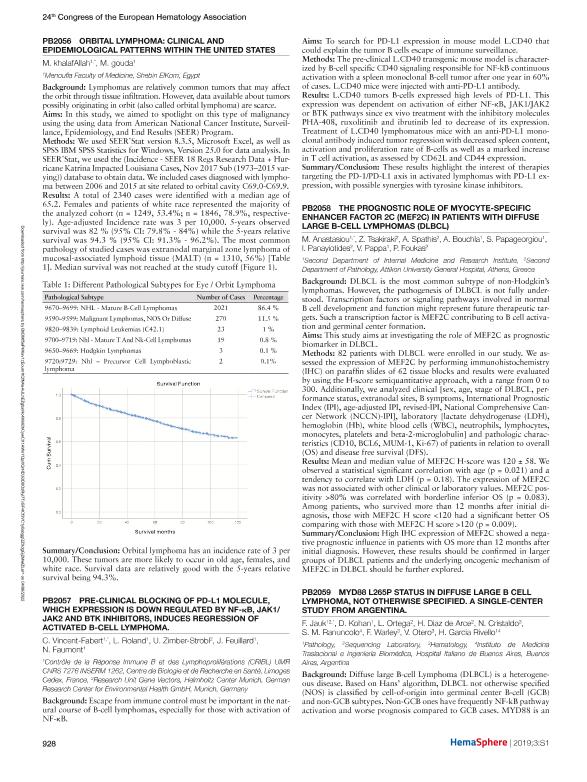Evento
Status in Diffuse Large B Cell Lymphoma not otherwise specified: A single center study from Argentina
Jauk, Federico; Kohan, Dana; Ortega, Leandro Ismael ; Diaz de Arce, Heidy; Cristaldo, Nancy; RANUNCOLO, Stella Maris
; Diaz de Arce, Heidy; Cristaldo, Nancy; RANUNCOLO, Stella Maris ; Warley, Fernando; Otero, Victoria; Garcia Rivello, Hernan Jorge
; Warley, Fernando; Otero, Victoria; Garcia Rivello, Hernan Jorge
 ; Diaz de Arce, Heidy; Cristaldo, Nancy; RANUNCOLO, Stella Maris
; Diaz de Arce, Heidy; Cristaldo, Nancy; RANUNCOLO, Stella Maris ; Warley, Fernando; Otero, Victoria; Garcia Rivello, Hernan Jorge
; Warley, Fernando; Otero, Victoria; Garcia Rivello, Hernan Jorge
Tipo del evento:
Congreso
Nombre del evento:
24th Congress of the European Hematology Association
Fecha del evento:
13/06/2019
Institución Organizadora:
Escuela Europea de Hematología;
Título de la revista:
Hematologica
Editorial:
Ferrata Storti Foundation
ISSN:
0390-6078
Idioma:
Inglés
Clasificación temática:
Resumen
BackgroundDiffuse large B-cell Lymphoma (DLBCL) is a heterogeneous disease. Based on Hans? algorithm, DLBCL not otherwise specified (NOS) is classified by cell-of-origin into germinal center B-cell (GCB) and non-GCB subtypes. Non-GCB ones have frequently NF-kB pathway activation and worse prognosis compared to GCB cases. MYD88 is an adaptor protein of toll-like and IL-1 receptor signalling, leading downstream NF-kB pathway activation. MYD88 L265P mutation confers the protein constitutional activation. This mutation is present in around 20% of non-GCB subtype, and rarely found in GCB subtype of DLBCL. The prognostic value of MYD88 L265P mutation in DLBCL has been matter of controversy.AimsThe aim of the study was to determine the prevalence of MYD88 L265P mutation in DLBCL NOS cases of Argentina, and compare it with previous reports in the literature.MethodsA retrospective cohort of 73 DLBCL NOS cases diagnosed in the Italian Hospital of Buenos Aires (Argentina) between 2010 and 2016 was studied. Complete clinical records, Hans? algorithm, and available material for molecular testing were inclusion criteria. Patients with prior diagnosis of low-grade lymphoma or diagnosis of immunodeficiency-associated, post-transplant, EBV+, primary mediastinal, primary testicular, primary CNS, primary effusion, leg-type or intravascular DLBCL were excluded. DNA was extracted from tissue blocks using QIAamp mini kit (Qiagen). MYD88 L265P was assessed using an in-house allele-specific probe-based Real-Time PCR assay. Positive (primary testicular DLBCL) and negative controls (tonsil) were added to each run. Every case was checked subsequently using qBiomarker MYD88 L265P Somatic Mutation Assay (Qiagen). Prevalences were expressed as percentage, confident intervals were calculated using Clopper-Pearson exact method. Kaplan Meier curves and Log-rank test were used to evaluate overall survival (OS).Results36 patients (49,31%) were female, and median age at diagnosis was 66 years (range 26-89). 33 patients (45,20%) had extranodal involvement (gastrointestinal tract: 14 cases; liver: 5 cases; bone: 4 cases; other locations: 10 cases). 44 cases (60,27%) were GCB and 29 (39,73%) were non-GCB DLBCLs. MYD88 L265P mutation was present in 2 cases (2,74% ; CI 95%: 0,33-9,55%) among all DLBCLs, including 1 GCB case (2,27% ; CI 95%: 0,06-12,02%) and 1 non-GCB case (3,45% ; CI 95%: 0,09-17.76%). There was no significant association between MYD88 L265P status, Hans´algorithm subtype, sex, age or Ki67 index and OS.ConclusionIn the analyzed population, the prevalence of GCB and non-GCB subtypes among DLBCL NOS cases was similar to international reports, although we did not find significant difference between both groups regarding OS (p=0,712). MYD88 L265P mutation was found only in 2 patients (1 GCB and 1 non-GCB), accounting for 2,74% (CI 95%: 0,33-9,55%) and 2,27% (CI 95%: 0,06-12,02%) of all DLBCL NOS and non-GCB cases, respectively. Both prevalences are significantly lower than those published in 2017 by Lee et al. in a meta-analysis, where they found that MYD88 L265P is present in 16% (CI 95%: 15-18,09%) and 20,63% (CI 95%: 18,41-23%) of patients among all DLBCLs and non-GCB subtype, respectively. However, MYD88 L265P prevalence in primary SNC, testicular and leg-type DLBCLs diagnosed in our institution are similar to the literature (data not shown).
Archivos asociados
Licencia
Identificadores
Colecciones
Eventos (IMTIB)
Eventos de INSTITUTO DE MEDICINA TRASLACIONAL E INGENIERIA BIOMEDICA
Eventos de INSTITUTO DE MEDICINA TRASLACIONAL E INGENIERIA BIOMEDICA
Citación
Status in Diffuse Large B Cell Lymphoma not otherwise specified: A single center study from Argentina; 24th Congress of the European Hematology Association; Amsterdam; Holanda; 2019; 1-2
Compartir



